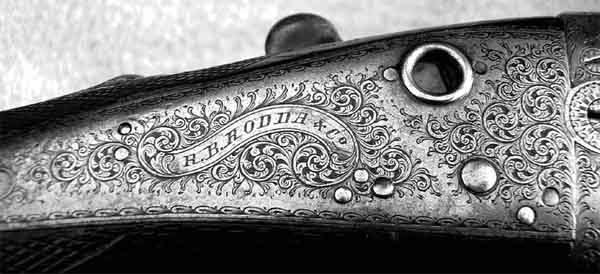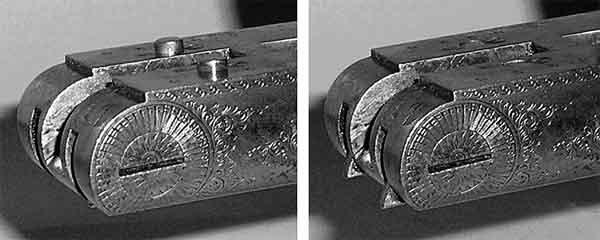A Vintage Rodda Double Express
The subject of this article is a rather well used but nevertheless quite sound hammerless side-lock double rifle chambered for an obsolete .500 express cartridge. Its provenance is not known prior to the 1970s, when it was confiscated from a 'person or persons unknown' by the Elephant Control Board on the Indonesian island of Sumatra. The rifle was subsequently disposed of by Government auction, at which time it was picked up by a visiting Australian (now-retired Perth gun-dealer and Mazeratti car buff, Bob H_ ) and brought back to Western Australia around 1979 or 1980. It has had several owners since then, including a Perth doctor (Harvey L_ ), and most recently the Maddington firearms dealer Bill B_ from whom I acquired it in February 2006.

The firearm weighs a little over 9 1/2 lbs with its 28-inch damascus barrels, and was initially retailed by the well-known Indian 'gun-making' firm of R.B. Rodda & Co in Calcutta. Despite the Rodda name proudly displayed in a banner amid bold acanthus scroll on each lock-plate, the firearm was undoubtedly built in Birmingham during the closing years of the 19th century by W. & C. Scott and Son.
Although a number of published sources attribute Rodda with a gun-making capability (including their very own catalogues at the time!), it is almost certain that they never actually made a single firearm themselves. Neither Nigel Brown nor Douglas Tate gives them any press whatsoever as Birmingham 'makers', while Wally Winfer describes them as "a retailer who had offices both in England and India", and as "another of the companies who were strictly retailers, they did no manufacturing themselves".
Rodda's 'premises' in Birmingham did indeed exist, at 50 Stafford St in 1908-09, 24 Whittall St from 1910 to 1931, 10 Vesey St from 1932 to 1939, and 17a Steelhouse Lane in 1940, but they were referred to as 'exporters' in the directories of the day. In keeping with the facade of the British trade, the right barrel of the subject rifle is engraved "R. B. Rodda & Co, London", while the left barrel bears the inscription "and 7 & 8 Dalhousie Square, Calcutta". Under no circumstances could the Rodda firm substantiate its claim to the status of a 'London Maker', despite the obvious inference on the right barrel!
Like many early sidelocks retailed in India and elsewhere, this rifle features Scott’s patent ‘Crystal Indicator’ locks with gilt tumblers visible through the transparent windows in the lock-plates. The 'Crystal Indicator' was an early hammerless design, intended to circumvent the mistrust of conservative sportsmen who still preferred visible evidence of whether or not a gun was cocked, in the absence of external hammers. The 'invention' was protected by Patent No. 3223 of 1875, granted to William Middleditch Scott.

The locks also feature Perkes-patent intercepting safeties, perhaps the most commonly encountered internal safety device on sidelocks of this vintage. The Perkes interceptor consists of a long arm with a hooked extremity intended to 'catch' the tumbler before it strikes the firing pin, in the event of the sear disengaging from the bent without the trigger being pressed.
This particular rifle is also fitted with mechanical cocking-rod retractors, consisting of small 'plungers' in the action flats. The plungers are depressed into the flats by closing the barrels, whereby they engage angled surfaces on the cocking rods, thus withdrawing the cockers from their contact with the breasts of the tumblers. These devices persisted on Scott-made guns for some time prior to the realization that they were entirely unnecessary!

The rifle is chambered for the .577/.500 No.2 Express, a bottle-neck black powder cartridge which is believed to have been developed by Westley Richards some time prior to 1879. It was never commercially loaded as a full nitro cartridge, giving way to the .500 3-inch straight case just before the turn of the last century. Curiously, the Rodda's action flats are stamped “CO EX” indicating that the rifle was proved for, and probably regulated with, the cordite express ‘nitro-for-black’ load.
According to the 1926 ICI catalogue, the .577/.500 No.2 ‘nitro for black’ cartridge was loaded with 53 grains of cordite. The ballistics table specifies a 440-grain .510 bluff-nose jacketed soft-point at 1675 fps, for 2743 ftlbs muzzle energy. The Taylor Knock-Out value would be 54 with 440gr solids, not brilliant by any means, but some 25% more than the .375 H&H Magnum.
I wasted no time in developing a modern accurate load for the Rodda, settling on 74gr of ADI AR2208 plus 2 half-inch saddle-felt wads beneath the 440gr Woodleigh 'Weldcore' bullet. Cases
were Australian Bertram brass. My handloads landed a little high on the test-target at 50 yards, but showed outstanding accuracy considering the rather dark bores. Composite 4-shot groups were always within a couple of inches, and R/L pairs were usually touching! The time was fast approaching to reacquaint this delightful vintage hunting rifle with its raison d'etre: the Asian water buffalo!

On the first trip, my wife Rebecca accompanied me for the bushwalking, and to help pack out any meat we might acquire. After a rather uneventful day following drainage lines around the base of the escarpment, we finally bumped into a small mob feeding in a weed-choked creek-bed in the late afternoon. We quickly ducked out to one side and knelt down in a dry overflow to cover their exit from the creek-line, and to pick out a fat cow or good bull, whichever presented the best shot as they filed past. I was still being cautious with this calibre (the cartridge is no giant killer!) but trusted the 440-grain Woodleighs to do the job.
I didn't count on the herd turning down the overflow and feeding straight towards us, as we crouched in the open trying to hide behind 6-inch tufts of grass! Two cows with calves were in the lead: luckily one had an obvious weaner because it was she that offered the first opportunity, turning

almost broadside at about 8 metres! With no time to lose, I gave her both barrels quickly behind the elbow, followed by a third into the off-side rib-cage, quartering forward, as she about-faced to flee. The stricken animal was down within a few metres, and quite dead by the time I reached her. Only one of the spent projectiles was recovered, from the third shot which had quartered forward and stopped at the front of the off-side
shoulder. It had not expanded much, but then penetration is the more important criterion on large game and this one managed almost a metre. One of the first two bullets had traversed the chest-cavity, centering a far rib but bouncing back inside despite breaking the bone. Couldn't find it, though! ...and only God knows where the other one ended up!

Based on these initial experiences with the .500 No.2, I would be quite confident taking the vintage Rodda against the biggest buffalo bull, providing he was undisturbed and offered
me a good view of his ribs. Few experiences can be as intensely satisfying to the hunter/collector as returning an old campaigner like this Rodda to the hunting field more than a century after its initial debut, and successfully bringing a buffalo to bag on the very first trip! It's a great credit to the skill and dedication of the original gunmakers all those years ago.